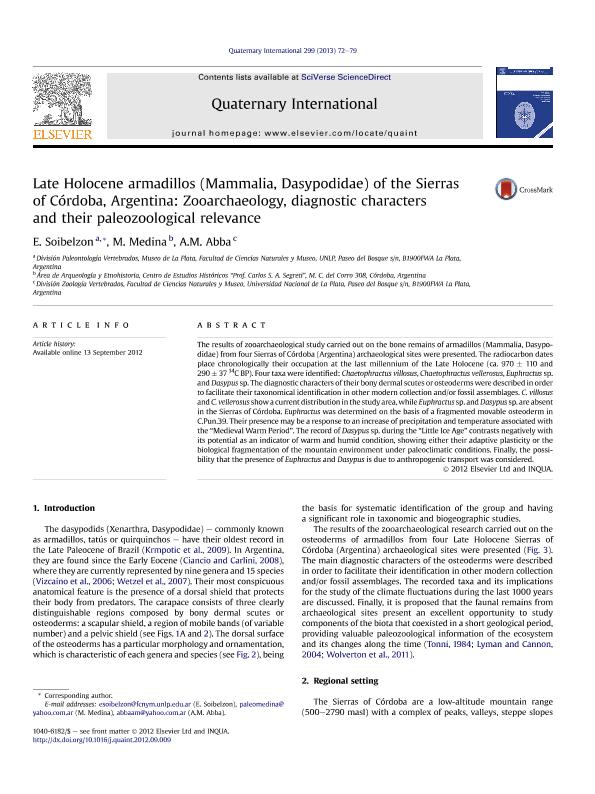Mostrar el registro sencillo del ítem
dc.contributor.author
Soibelzon, Esteban

dc.contributor.author
Medina, Matias Eduardo

dc.contributor.author
Abba, Agustin Manuel

dc.date.available
2019-05-20T22:14:34Z
dc.date.issued
2013-06
dc.identifier.citation
Soibelzon, Esteban; Medina, Matias Eduardo; Abba, Agustin Manuel; Late Holocene armadillos (Mammalia, Dasypodidae) of the Sierras of Córdoba, Argentina: Zooarchaeology, diagnostic characters and their paleozoological relevance; Pergamon-Elsevier Science Ltd; Quaternary International; 299; 6-2013; 72-79
dc.identifier.issn
1040-6182
dc.identifier.uri
http://hdl.handle.net/11336/76761
dc.description.abstract
The results of zooarchaeological study carried out on the bone remains of armadillos (Mammalia, Dasypodidae) from four Sierras of Córdoba (Argentina) archaeological sites were presented. The radiocarbon dates place chronologically their occupation at the last millennium of the Late Holocene (ca. 970±110 and 290±3714CBP). Four taxa were identified: Chaetophractus villosus, Chaetophractus vellerosus, Euphractus sp. and Dasypus sp. The diagnostic characters of their bony dermal scutes or osteoderms were described in order to facilitate their taxonomical identification in other modern collection and/or fossil assemblages. C. villosus and C. vellerosus show a current distribution in the study area, while Euphractus sp. and Dasypus sp. are absent in the Sierras of Córdoba. Euphractus was determined on the basis of a fragmented movable osteoderm in C.Pun.39. Their presence may be a response to an increase of precipitation and temperature associated with the "Medieval Warm Period". The record of Dasypus sp. during the "Little Ice Age" contrasts negatively with its potential as an indicator of warm and humid condition, showing either their adaptive plasticity or the biological fragmentation of the mountain environment under paleoclimatic conditions. Finally, the possibility that the presence of Euphractus and Dasypus is due to anthropogenic transport was considered.
dc.format
application/pdf
dc.language.iso
eng
dc.publisher
Pergamon-Elsevier Science Ltd

dc.rights
info:eu-repo/semantics/openAccess
dc.rights.uri
https://creativecommons.org/licenses/by-nc-sa/2.5/ar/
dc.subject
Archaeofauna
dc.subject
Little Ice Age
dc.subject
Medieval Warm Period
dc.subject
Xenarthra
dc.subject
Osteoderm
dc.subject.classification
Historia

dc.subject.classification
Historia y Arqueología

dc.subject.classification
HUMANIDADES

dc.title
Late Holocene armadillos (Mammalia, Dasypodidae) of the Sierras of Córdoba, Argentina: Zooarchaeology, diagnostic characters and their paleozoological relevance
dc.type
info:eu-repo/semantics/article
dc.type
info:ar-repo/semantics/artículo
dc.type
info:eu-repo/semantics/publishedVersion
dc.date.updated
2019-05-14T21:06:59Z
dc.journal.volume
299
dc.journal.pagination
72-79
dc.journal.pais
Estados Unidos

dc.description.fil
Fil: Soibelzon, Esteban. Consejo Nacional de Investigaciones Científicas y Técnicas. Centro Científico Tecnológico Conicet - La Plata; Argentina. Universidad Nacional de La Plata. Facultad de Ciencias Naturales y Museo. División Paleontología Vertebrados; Argentina
dc.description.fil
Fil: Medina, Matias Eduardo. Consejo Nacional de Investigaciones Científicas y Técnicas. Centro Científico Tecnológico Conicet - La Plata; Argentina. Centro de Estudios Históricos "Profesor Carlos S. A. Segreti"; Argentina
dc.description.fil
Fil: Abba, Agustin Manuel. Consejo Nacional de Investigaciones Científicas y Técnicas. Centro Científico Tecnológico Conicet - La Plata; Argentina. Universidad Nacional de La Plata. Facultad de Ciencias Naturales y Museo. División Zoología de Vertebrados; Argentina
dc.journal.title
Quaternary International

dc.relation.alternativeid
info:eu-repo/semantics/altIdentifier/url/https://www.sciencedirect.com/science/article/pii/S1040618212031825
dc.relation.alternativeid
info:eu-repo/semantics/altIdentifier/doi/http://dx.doi.org/10.1016/j.quaint.2012.09.009
Archivos asociados
